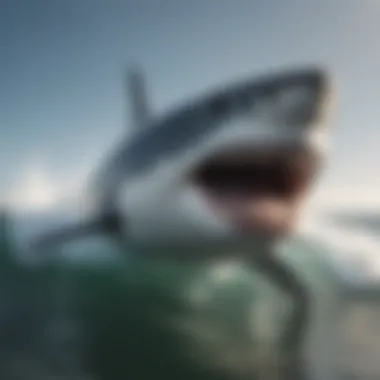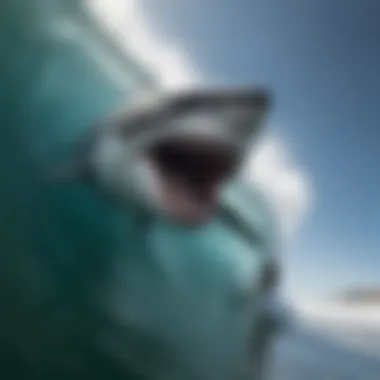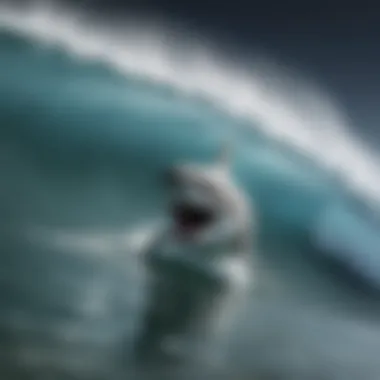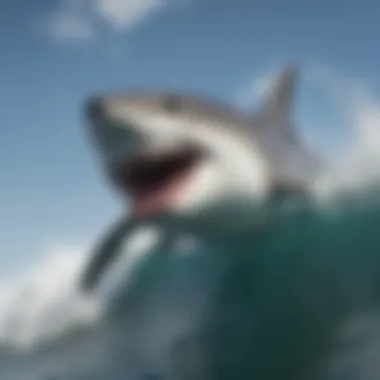Great White Sharks: Their Role and Predators in the Ocean


Intro
The vast expanse of our oceans is an intricate tapestry woven with countless organisms, each playing a vital role in the environment. Among the most formidable residents of these waters is the great white shark, a species steeped in both reverence and mystery. While they are often portrayed as the apex predators of the sea, the reality is more complex than popular media may suggest. This article aims to peel back the layers of this narrative, exploring the ecological significance of great white sharks and their place within the ocean's hierarchy.
With their powerful physique and keen senses, great white sharks dominate the food chain. Yet, despite their status, they are not entirely free from the threat of predation. In this exploration, we’ll investigate the lesser-known aspects of these ocean giants, such as the species that could pose a risk to them, and assess how their existence contributes to marine ecosystems.
To fully understand the great white's ecological role, one must also consider the impact of human activities. Overfishing, pollution, and climate change are just a few of the factors that have profound effects on their populations and behaviors. Our journey will take us from underappreciated contenders of the ocean realm to the dramatic influence that humanity has on this majestic species.
As we navigate through their significant interactions with other marine life, we’ll uncover both competition and symbiosis in this intricate ecosystem. Are great white sharks the rulers of the ocean, or is their place more tenuous than previously thought? Join us as we unravel these pressing questions and uncover the truth about the ocean's predatory hierarchy.
Preamble to the Great White Shark
The great white shark stands as a symbol of raw marine power and intrigue. Known scientifically as Carcharodon carcharias, this apex predator commands respect across oceans, striking fear and fascination into the hearts of many. Their towering presence in the underwater hierarchy is one of the reasons why they have captivated so many, from surfers riding the waves to scientists delving into the mysteries of marine biology.
To understand the ecological significance of the great white shark, it’s vital to highlight several components. First, their role as top predators stabilizes marine ecosystems. By regulating populations of other species, especially seals and fish, they contribute to the overall health of ocean habitats. Without them, the intricate balance of the food web could easily tilt, leading to unforeseen consequences.
Furthermore, the great white is more than just a fearsome hunter. Each encounter or interaction with humans, whether in surf sports or documentary filmmaking, deepens our connection to this majestic creature. When surfers paddle out, they not only seek thrills but also immerse themselves in the delicate dance of coexistence in the ocean. Understanding great whites offers insight into how we relate to the natural world.
It's also essential to consider some critical points surrounding the great white shark's existence:
- Behavioral Patterns: Grasping their behaviors aids in recognizing when and where to spot them, creating a bridge between adventure and awareness.
- Ecological Significance: Acknowledging their impacts increases understanding of marine health and conservation priorities.
- Human Relationship: Exploring our interactions with these creatures highlights conservation needs and creates dialogue on sustainable practices.
In summary, the great white shark is not just a terrifying figure in the deep; it represents a complex layer of life in oceanic ecosystems. This article will guide you through exploring their ecological standing, natural relationships, and the threats they face, paving ways for a nuanced appreciation of these remarkable marine beings.
The great white shark is the embodiment of the ocean's spirit, commanding respect while being a centerpiece of marine life.
Defining the Great White Shark
The great white shark, or Carcharodon carcharias, stands out as one of the most recognized and feared predators in the ocean. To grasp its role in the marine ecosystem, we must first unlock the definition of this majestic creature. Defining the great white shark goes beyond mere physical description; it encapsulates its ecological importance, behavior, and adaptability to varying oceanic environments.
Understanding the characteristics and behaviors of great white sharks can benefit not only marine biologists but also a variety of other fields—including conservation and tourism industries. Surfboarders often seek areas frequented by these sharks, marketers develop safety guidelines and products for ocean enthusiasts, and travel planners design tours highlighting the thrill of encountering these predators in their natural habitat.
Physical Characteristics
Great white sharks can be identified by their distinctive features: a sleek body often reaching lengths of up to 20 feet, with a powerful jaw designed for gripping and tearing flesh. Their upper bodies display a gray or blue hue, providing excellent camouflage against the ocean depths, while their undersides are white, aiding in evasion from any predators lurking below.
This coloration has made the great white an expert ambush predator. They possess numerous sharp teeth, adapted for a predatory diet consisting mainly of seals, sea lions, and smaller fish. The unique contour of their mouths allows for an impressive bite force—among the strongest in the animal kingdom.
In addition to the external features, it's critical to note the internal physiology that allows them to navigate a wide range of oceanic conditions. Their ability to regulate body temperature assists them in hunting in colder waters, while their keen sense of smell equips them to detect prey from miles away.
Behavioral Traits
When talking about great white sharks, their behavioral traits play an equally significant role in defining their nature. These sharks are often characterized by their curiosity and solitary tendencies. Unlike many social fish, great whites tend to roam alone, although some individuals may form temporary schools during feeding events.
Their hunting strategy can be described as a blend of patience and precision. Great whites often engage in a thrilling behavior known as breaching, where they launch themselves out of the water to seize their prey from below. This breathtaking display serves both as an effective hunting tactic and a means of asserting dominance in their territory.
"Great whites are not just mindless killers; they exhibit complex social behaviors that surprise researchers all the time."
Moreover, these sharks are capable of long migratory patterns, traveling thousands of miles to find suitable feeding grounds, often influenced by seasonal prey movements. This adaptability is essential for their survival, especially in fluctuating environments. They demonstrate the ability to hunt during different times of the day, showing no strict preference for daylight or night operations, and are known to visit various habitats—from coastal waters to the open ocean.
In summary, defining the great white shark encompasses its remarkable physical traits and unique behaviors, both of which underscore its vital role within the oceanic hierarchy and intricate predator-prey dynamics.
The Ecological Role of Sharks
The perspective of sharks as mere killers is a pretty narrow view, especially when looking at their ecological role. Sharks, including the great white, hold a crucial position within marine ecosystems. They act as pivotal predators whose behaviors and activities help maintain the balance of ocean life. Their presence greatly impacts the structure of various marine communities, shaping populations of prey species and, consequently, influencing the complex web of life beneath the sea's surface.
Understanding this role provides insight into why, without sharks, the health of our oceans hangs in the balance. It’s not just about the thrill of the chase or the rush of spotting one on a dive; it’s about the overall health of marine ecosystems.
Top Predators in Marine Environments


At the top of the food chain in the ocean, sharks like the great white are sometimes called apex predators. But this title might be more nuanced than it appears. Great whites primarily prey on larger fish, seals, and even smaller sharks, showcasing a diverse diet that includes both mesopredators and other species. Some believe that their hunting strategies—like ambushing and breaching—allow them to capitalize on weaknesses in marine prey behavior.
Moreover, these sharks contribute to regulating populations of prey species, which helps to foster biodiversity. When the prey populations spike, competition for resources becomes fierce, often leading to negative impacts on the overall ecosystem. Sharks nibble away at this imbalance, preventing any single species from taking over.
- Orcas, for instance, are known to hunt great whites, sometimes targeting them in coordinated group efforts, particularly when they seek the fatty livers of their prey.
- Larger sharks, although few, also pose a threat to juvenile great whites when they’re at their most vulnerable.
The interplay between these species doesn’t just demonstrate how interconnected ecosystems are; it reveals that even apex predators are part of a larger community, influencing each other’s survival and behavior.
Impact on Ocean Health
Sharks critically affect ocean health, and their absence is felt far beyond just one species. Removing sharks from an ecosystem can trigger a domino effect, known as mesopredator release. When sharks are taken out of the equation, smaller predatory fish often multiply unchecked, leading to a decline in their own prey species. This cascade can change the structure of marine environments, affecting habitats critical for various marine life.
In a nutshell, healthy shark populations signify balanced ecosystems. Here’s how sharks contribute to ocean well-being:
- They help maintain the balance of marine populations, supporting aquatic biodiversity.
- Their movement through water encourages nutrient cycling, which promotes overall health in ocean habitats.
- As scavengers on occasion, sharks remove dead animals, contributing to ocean cleanliness.
Common Misconceptions about Great White Sharks
When it comes to great white sharks, many have a jaded view shaped by sensationalized media portrayals and age-old folktales. This tendency to misinterpret their behaviors or roles in the ocean can lead to widespread misconceptions, which in turn affects conservation efforts and public perception. When we clarify these misunderstandings, we start to see the true ecological significance of these giants and their actual behavior. Misconceptions can taint the narrative around these magnificent creatures, fostering fear rather than respect. Understanding what’s fact and what’s fiction is crucial, especially for those directly interacting with marine environments, like surfboarders or travel planners. Knowledge dispels fear, enabling humans to coexist with these creatures more harmoniously.
Myths Surrounding Shark Attacks
Shark attacks are a primary source of fear, often leading people to believe that great white sharks are uncontrollable killing machines. However, this notion is greatly exaggerated. Statistically, the chance of being attacked by a shark is disturbingly low. In fact, reports show that you are more likely to get struck by lightning or injured in a car accident than to be bitten by a shark. The portrayal of these attacks often neglects critical context.
- Misidentification: Many attacks occur when a shark mistakes a surfer for prey. Quite often, once they realize it is not a seal, they swim away.
- Protective Behavior: In many instances, when a shark bites a human, it’s simply an act of curiosity or a defensive maneuver.
- Infrequent Incidents: The reality is that fatal attacks are rare. The International Shark Attack File reports that since the year 2000, fatalities have averaged under 10 worldwide. In reality, humans pose a far greater threat to sharks than they do to us.
"Shark attacks have become the stuff of legend, yet in truth, they are unnervingly rare events fueled by myth and misunderstanding."
Understanding Shark Behavior
To truly appreciate great white sharks and their behavior requires stepping back from fear-based narratives and examining their natural instincts. Understanding their behavior opens a door to respecting their role in the marine ecosystem. Great whites have complex social interactions and communication methods, often relying on body language and subtle environmental cues.
- Territoriality: While they are known to roam vast ocean distances, great whites can be quite territorial, especially during mating seasons or when feeding.
- Intelligent Hunters: They employ intricate hunting techniques. For instance, they sometimes spy-hop—raising their heads above the water—to survey their surroundings.
- Learning Adaptation: These sharks show remarkable adaptability, changing their behaviors based on prey availability or environmental factors. Some studies suggest that great whites can even learn from past experiences, a sign of their cognitive abilities.
In sum, when we peel away the misconceptions surrounding the great white shark, we see a more nuanced picture. These sharks are not simply mindless predators, but rather a vital part of the marine ecosystem that deserve our understanding and protection.
Predators of the Great White Shark
The topic of great white shark predators is not just an academic curiosity; it adds another layer of complexity to our understanding of marine ecosystems. While great whites are often regarded as the apex predators of the ocean, they don’t exist in a vacuum. Recognizing their limited circle of predators can help paint a clearer picture of their ecological role and interactions with other species. This section will delve into the primary predators of great white sharks, expanding upon their interactions in the marine food web and the implications for conservation and research efforts.
Orcas as Natural Predators
Orcas, or killer whales, stand out as one of the few natural predators of great white sharks. These intelligent marine mammals are not only adept hunters but also exhibit complex social behaviors that enable them to hunt in groups. Studies have shown that orcas can target specific sharks, flipping them upside down to induce a state called tonic immobility, which makes them temporarily paralyzed. This strategy allows orcas to strike effectively, often targeting the liver, which is rich in nutrients.
In locations like the coastal waters of South Africa and California, orcas have been recorded specifically targeting great whites, leading to significant decreases in their local populations. The impact of these predatory interactions highlights the interconnectedness of oceanic life.
"The presence of orcas in an area can dramatically affect the behavior and distribution of great whites, illuminating the balance of the marine food web."
From an ecological standpoint, understanding the relationship between orcas and great white sharks highlights the intricacies of predator-prey dynamics. Such connections underscore the importance of protecting both species, as shifts in one can influence the other and cascade throughout the marine ecosystem.
Juvenile Sharks and Their Vulnerability
Juvenile great white sharks face an uphill battle for survival. While adult individuals often sit at the top of the marine food chain, the young sharks are more vulnerable to threats. Smaller sharks may fall prey to a suite of opportunistic predators, including larger fish like bull sharks and even other great whites. Their size and inexperience make them prime targets when they venture into shallower waters, where numerous predators lurk.
Moreover, the habitats where young great whites grow up can contribute to their vulnerability. Coastal nursery areas, while providing some protection, can also expose them to a variety of threats. Human activities like fishing and pollution further complicate their survival, drawing attention to the necessity of habitat protection for these young sharks.
The contrasts between juvenile and adult great whites illustrate the challenges faced at different life stages. Recognizing the threats that juvenile sharks encounter can help drive conservation initiatives aimed at safeguarding their nursery habitats and enhancing their survival rates.
In summation, while great white sharks command a significant place in the ocean's hierarchy, they are not entirely free from the threat of predation. Orcas present a unique challenge to the great whites, and juvenile sharks remain at risk throughout their early development. These factors must be considered in any discussion of great white sharks’ ecological dynamics and conservation strategies.
Factors Affecting Shark Survival


Sharks, including the famous great white, face challenges that can impact their very existence. The importance of understanding what threatens their survival cannot be overstated—it’s not only about keeping a feared predator in our oceans but ensuring the overall health of marine ecosystems. Several specific elements play critical roles in the survival of these magnificent creatures, including habitat loss and human-driven activities.
Habitat Loss and Its Consequences
The ocean is a dynamic environment, but changes brought about by human activity can unearth dire consequences for great whites and their habitat. Coastal development, pollution, and climate change create an environment where nurseries and breeding grounds become scarce. The impact of habitat loss is two-fold: it diminishes the shark populations directly by reducing their living spaces, and indirectly by affecting prey availability.
- Nursing Areas: Young sharks often rely on sheltered areas for growth, where they are more protected from larger predators. Destruction of these spots due to coastal construction means juvenile sharks are left vulnerable.
- Coral Reefs and Seagrass Beds: These vibrant ecosystems are crucial for providing a food source. When they suffer degradation, the whole food web fluctuates, impacting not just great whites but countless other marine species.
A poignant reminder is that when sharks lose their habitat, so do countless other species that share their ecosystem, leading to an imbalance that can ripple through the food chain.
Human Encroachment and Fishing
Human activities encroach on the oceans at a staggering rate. Fishing, in particular, poses an immediate threat to great whites. These aren’t just about the act itself; it’s about how we fish.
- Bycatch: Many sharks fall victim to fishing methods that ensnare them unintentionally. Longlines, nets, and traps target other fish, but can often yield sharks as collateral damage. The growth of commercial fisheries further exacerbates this issue by depleting shark populations.
- Overfishing of Prey: When we reel in too many smaller fish species—the primary food for great whites—we inadvertently weaken the sharks’ ability to survive. Their hunting prowess, fine-tuned over centuries, begins to falter without enough food.
Additionally, the demand for shark fins drives some of the most grievous acts of overfishing, resulting in high mortality rates for these animals, not to mention the ethical implications.
"The oceans are a fine balancing act, and when a key player like the great white is out of sync due to human impact, the entire oceanography can shift."
Ultimately, understanding these factors is crucial for the survival of great white sharks. Conservation efforts need to be informed by an awareness of how habitat loss and human encroachment play roles in this species' ongoing battle to endure in an increasingly threatened environment.
The Impact of Climate Change on Shark Populations
Understanding the impact of climate change on shark populations is crucial to grasping the overall health of marine ecosystems. Great white sharks, like many marine species, face challenges that stem from shifting oceanic conditions. These changes not only affect the sharks directly but also have far-reaching implications for their prey and other species within the same habitats.
Climate change can bring about a hotter planet, resulting in rising ocean temperatures. This phenomenon can disrupt the delicate balance of marine life. Warmer waters can lead to changes in breeding patterns, migratory routes, and even the prevalence of certain species. For instance, many fish species shift their habitats in search of cooler waters, consequently altering the available prey for predators like the great white shark. If these sharks find themselves navigating a landscape devoid of their usual food sources, it could drastically affect their survival rates and reproductive success.
"Climate change is a slow-moving beast, but its consequences on marine life are immediate and profound."
Changes in Ocean Temperature
The first significant aspect to consider is the rise in ocean temperatures. As oceans warm, it affects nutrient cycling and can lead to harmful algal blooms, which can be toxic to marine life, including sharks. Warmer water holds less oxygen, leading to hypoxic conditions that many marine species cannot survive. Sharks, known for their sensitivity to such changes, may struggle to adapt. The shift in temperature can push them out of their traditional habitats, forcing competition for dwindling resources in unfamiliar areas.
It’s also worth noting that the breeding behaviors of sharks can be sensitive to temperature changes. Temperature can influence the timing of mating seasons and the viability of shark pups. In colder regions, such as areas near Antarctica, the relatively sudden warming can decimate local shark populations as their breeding grounds become less favorable. This situations calls into question the long-term sustainability of great white sharks as a species in increasingly warmed waters.
Impacts on Prey Availability
The availability of prey species is directly affected by what’s happening within the climate. Many fish populations, essential to great whites, are moving towards the poles as they seek cooler temperatures. This shift challenges the great white shark’s hunting strategies since localized prey species may no longer be within their reach. Not to mention, the intricate balance between predator and prey can be thrown out of whack, leading to unexpected decline in great white numbers.
Furthermore, if species that great whites rely on for food — like sea otters or certain types of fish — suffer from overfishing, habitat loss, or temperature changes, it can spiral down to subsistence issues for the sharks themselves.
Additionally, the health of marine ecosystems hinges on the proper qualifications of various species. Take kelp forests, for example, where juvenile fish find shelter and grow. These locations are often impacted by ocean temperature and conditions created by climate change, nudging them towards extinction. Reduced juvenile populations mean fewer adults to sustain predation pressure, leading to a long-term impact on the population of great white sharks.
In summary, the nuances of climate change present a complex web of threats to shark populations. Changes in ocean temperatures and prey availability can have cascading effects. As conditions evolve, so must our understanding and efforts in conservation, lest we lose these apex predators and the vital roles they play in our oceans.
Research and Conservation Efforts
Research and conservation efforts concerning great white sharks are critical not just for the preservation of the species but for maintaining the overall balance within marine ecosystems. These efforts shed light on the ecological role of these apex predators and help to debunk myths that surround them. Understanding their behavior, migratory patterns, and hunting strategies allows scientists to create effective conservation strategies that protect not only the sharks themselves but the ocean environments they inhabit.
Studying Shark Behavior in the Wild
Studying great white sharks in their natural habitat is no small feat. Researchers often employ advanced tagging techniques to monitor their movements. This tracking provides invaluable data on their feeding habits and migration routes. For example, scientists have discovered that great whites travel thousands of miles between feeding and breeding areas, often following seasonal prey migrations.
- Technological Aids: The use of satellite tags has revolutionized the way researchers collect data. These tags relay real-time information, allowing researchers to observe patterns that would have been impossible to detect otherwise.
- Behavioral Insight: Understanding how great whites interact with their environment enhances our knowledge of their predation strategies. It reveals how they adapt to changing conditions, which is essential data for predicting their responses to environmental stressors.
Despite these efforts, studying great whites can be challenging. Their elusive nature and the vast expanses of the ocean present significant obstacles. Yet, collaborative projects between scientists, local communities, and conservation organizations have begun to bridge these gaps, fostering a new wave of learning and protection for these magnificent creatures.
Protection Initiatives


Various protection initiatives have emerged globally to safeguard great white sharks from human threats.
- Legislation: In numerous regions, laws have been implemented to prohibit the hunting of great whites. For instance, in California, the great white shark is fully protected under both state and federal law, reflecting a commitment to preserving this species.
- Marine Protected Areas (MPAs): Establishing MPAs is another critical strategy. These zones limit human activities that can harm shark populations, allowing ecosystems to thrive without interference. For example, the introduction of MPAs along the coast of South Africa has shown promise in hosting vibrant marine life, including the great white shark.
"The ocean’s rhythm is delicate, and sharks are its percussion. Protecting them is akin to safeguarding a heartbeat in a vastly interconnected symphony of life."
Conservation organizations also engage in public awareness campaigns. These efforts emphasize the importance of sharks in maintaining ocean health and encourage sustainable practices among coastal communities. Educating the public helps reduce negative perceptions of sharks, fostering a culture of conservation and respect.
Cultural Perspectives on Great White Sharks
Understanding cultural perceptions of great white sharks unveils a rich tapestry of narratives, beliefs, and emotions that influence how these creatures are viewed across the globe. This discussion is pivotal as it helps contextualize the ecological role of great white sharks within human society and highlights the interplay between fear, respect, and misunderstanding that surrounds these apex predators.
Representation in Media
Media has a significant effect on public views of great white sharks. From Hollywood blockbusters like Jaws to documentaries showcasing their beauty and complexity, the representation of these sharks shapes societal narratives. Generally, films tend to emphasize their ferocity, fostering a sense of fear. This portrayal often overlooks their ecological importance and fascinating behaviors.
- Fear vs. Fascination: Films often highlight shark attacks, breeding a fear that detracts from the reality of these creatures. In contrast, documentaries such as Sharkwater aim to educate audiences about their role in marine ecosystems and promote conservation efforts.
- Social Media Influence: Platforms like Instagram and TikTok have amplified visuals of great white sharks, sparking fascination. Videos that showcase great white sharks hunting or breaching attract millions of views, leading to a growing interest in their behavior and biology.
This duality of representation can at times leave the public confused. A fear driven by sensationalized media clashes with growing awareness and appreciation fostered by more educational content.
Symbolism in Folklore
Cultural narratives often frame the great white shark as a powerful symbol, varying greatly across societies. For some coastal Indigenous communities, sharks embody strength and resilience, serving as guardians of the sea. Their depictions in folklore often tell of encounters that highlight respect for these creatures and emphasize their integral role in the marine ecosystem.
- Guardians of the Sea: In many cultures, sharks are viewed as symbols of wisdom and protection. They are seen as guardians that maintain balance in oceanic communities. This perspective fosters a sense of reverence, contrasting sharply with the fear-based narratives prevalent in mainstream media.
- Cautionary Tales: Conversely, some stories depict sharks as harbingers of danger, warning of the perils of venturing too far into unknown waters. These cautionary tales reflect human fears and the mysteries of the ocean, and they serve as reminders of respect for nature’s unpredictability.
By looking at the great white shark through these cultural lenses, we gain insight into the broader human relationship with nature and the oceans. The evolving narratives can influence conservation efforts and community attitudes towards these creatures, ultimately shaping their fate within oceanic ecosystems.
“Cultural perceptions are critical as they impact the management and conservation strategies that societies employ. To protect great white sharks, it is essential to bridge the gap between fear and understanding.”
As we continue to explore the dynamic interactions between humans and great white sharks, recognizing these cultural perspectives is crucial. It not only informs our understanding of this apex predator but also emphasizes the need for a more nuanced conversation surrounding their conservation and ecological significance.
Future Outlook for Great White Sharks
The future of great white sharks is a pressing topic, especially given the shifting dynamics within marine ecosystems. As apex predators, their well-being is intricately linked to the health of the oceans. Understanding future outlooks for this species is not just an academic pursuit but a critical necessity for conservationists, marine biologists, and anyone invested in oceanic health.
The challenges facing great whites are numerous, from climate change to shifting prey populations. These factors directly impact their survival and reproductive success. In a world where things are constantly changing, forecasting population trends involves evaluating a myriad of elements. For instance, an increase in ocean temperatures could lead to shifts in prey availability, making it essential to predict how these changes will ripple through the food web.
Moreover, recognizing that human interactions, through fishing and habitat encroachment, pose a significant threat to great whites’ populations is vital. Each decision made in terms of marine policy or conservation efforts can have far-reaching consequences on these creatures. Not only will this inform future generations about the necessity of protecting great whites, but it will also solidify their role in the oceanic hierarchy.
Predictions on Population Trends
Predicting population trends of great white sharks requires examining several key indicators. Evidence suggests that overfishing, environmental degradation, and climate change could push numbers down if current practices persist.
- Data Collection: Continuous monitoring of great white populations is necessary. Notable studies have indicated that certain regions, like the coast of California, show fluctuations based on hunting regulations and ecological changes.
- Migration Patterns: They are known for long migrations; however, shifts in prey can disrupt these patterns. If sardine schools move due to warmer waters, this could push sharks to adapt or risk lower reproductive success.
- Human Activity: Coastal development and fishing practices significantly impact their populations. Proactive measures and stricter regulations could see a rebound in certain areas, suggesting a cautious optimism if conservation efforts stay robust.
Role of Technology in Conservation
Technology is becoming increasingly important in conservation efforts aimed at protecting great whites. Innovative practices are not just a flash in the pan; they’re changing the game altogether.
- Tracking and Monitoring: Satellite tags and underwater drones help track movements and behaviors, offering insights into their mating, feeding, and migratory habits. Knowledge gained from these technologies aids in understanding populations better and highlighting areas that need conservation efforts.
- Public Engagement: Social media platforms like Facebook or Reddit serve to raise awareness. Various organizations are using these to inform the public about great whites, engaging them in discussions, and promoting conservation initiatives.
- Data Analysis: Big data analytics is transforming how we interpret ecological data. By utilizing complex algorithms, researchers can forecast trends and human impacts much more accurately than ever before.
Epilogue
The examination of the great white shark's place in the ocean reveals much more than their fearsome reputation as apex predators. In this exploration, we've uncovered various elements that demand our attention for a clearer understanding of their ecological significance.
Understanding the Balance
Great white sharks play a crucial role in maintaining the health of marine ecosystems. Their predatory presence helps control populations of species lower in the food chain, contributing to balanced marine communities. This balance is vital not only for the sharks themselves but for the entire oceanic environment. Emerging evidence suggests that a decline in shark numbers leads to unchecked prey populations, which can have cascading effects on the ecosystem.
Predators of the Great White
The acceptance that even great whites have natural predators, such as orcas, disrupts the long-held notion of their invulnerability. The dynamics of predator-prey relationships become clearer, giving us insights into the ocean's complexities. This raises the question of how these interactions might evolve with changes in ocean health.
"The ocean holds secrets, and every creature plays a part in its grand design."
Human Impact
Equally important is the consideration of human impact on the great white shark. Overfishing, habitat loss, and climate change pose significant threats to their populations. Without addressing these concerns, the predator's role, and in extension the entire marine ecosystem, faces jeopardy. Therefore, public awareness, policy changes, and conservation initiatives are crucial for the future of great white sharks.
Looking Ahead
Reflecting on the implications of our findings, we recognize the importance of active engagement in marine conservation. By understanding the complexities of the oceanic hierarchy and the position great white sharks hold within it, stakeholders can make informed decisions that safeguard the health of marine environments. This ultimately fosters a more sustainable relationship between humans and the ocean.
To encapsulate, the great white shark is not merely a symbol of fear but a pivotal player in the delicate tapestry of ocean life. Their preservation is intertwined with the broader health of our seas—an understanding that should drive both individual actions and collective policies moving forward.















